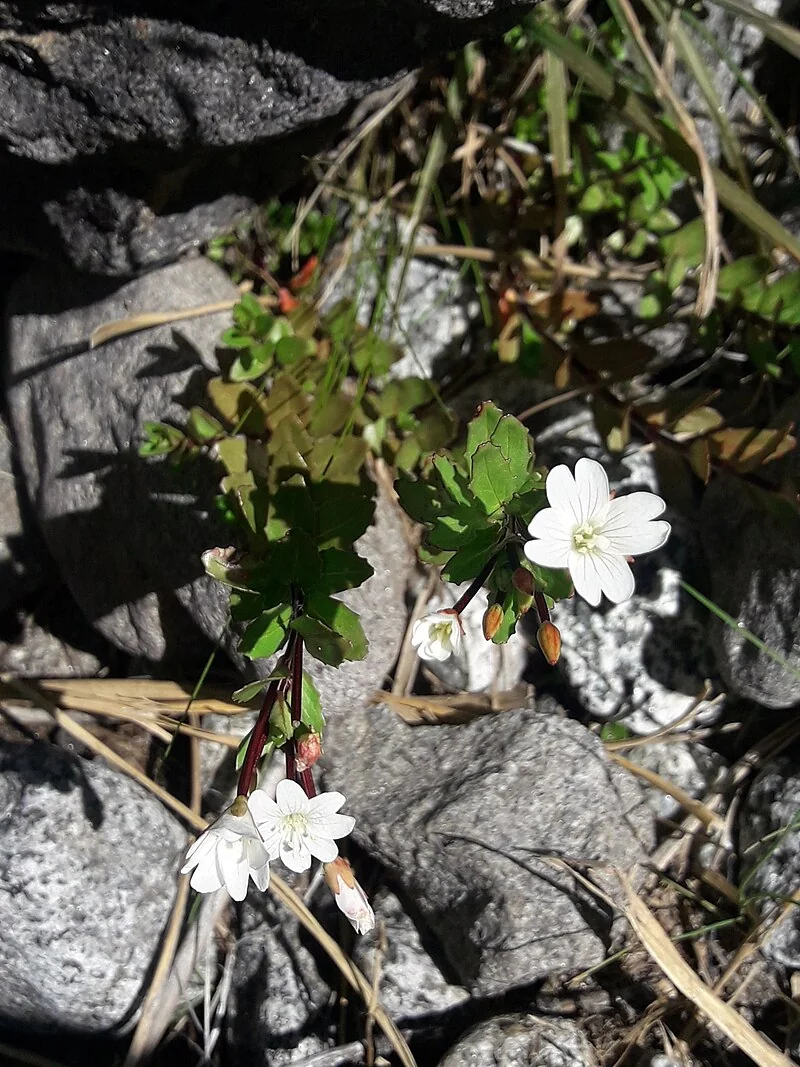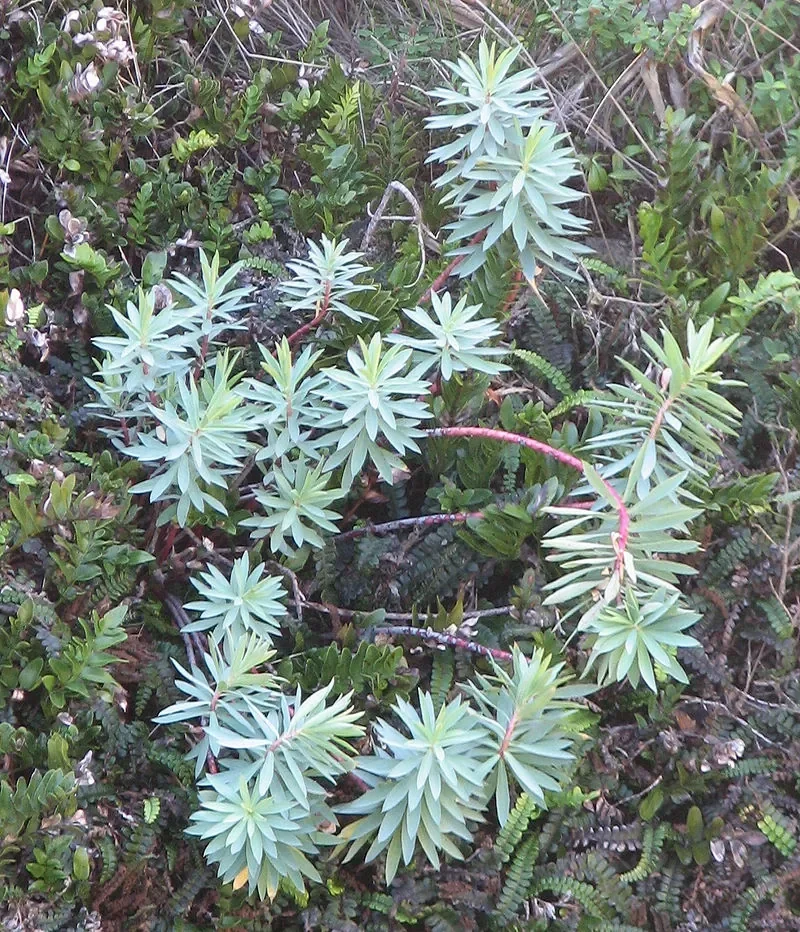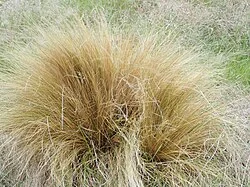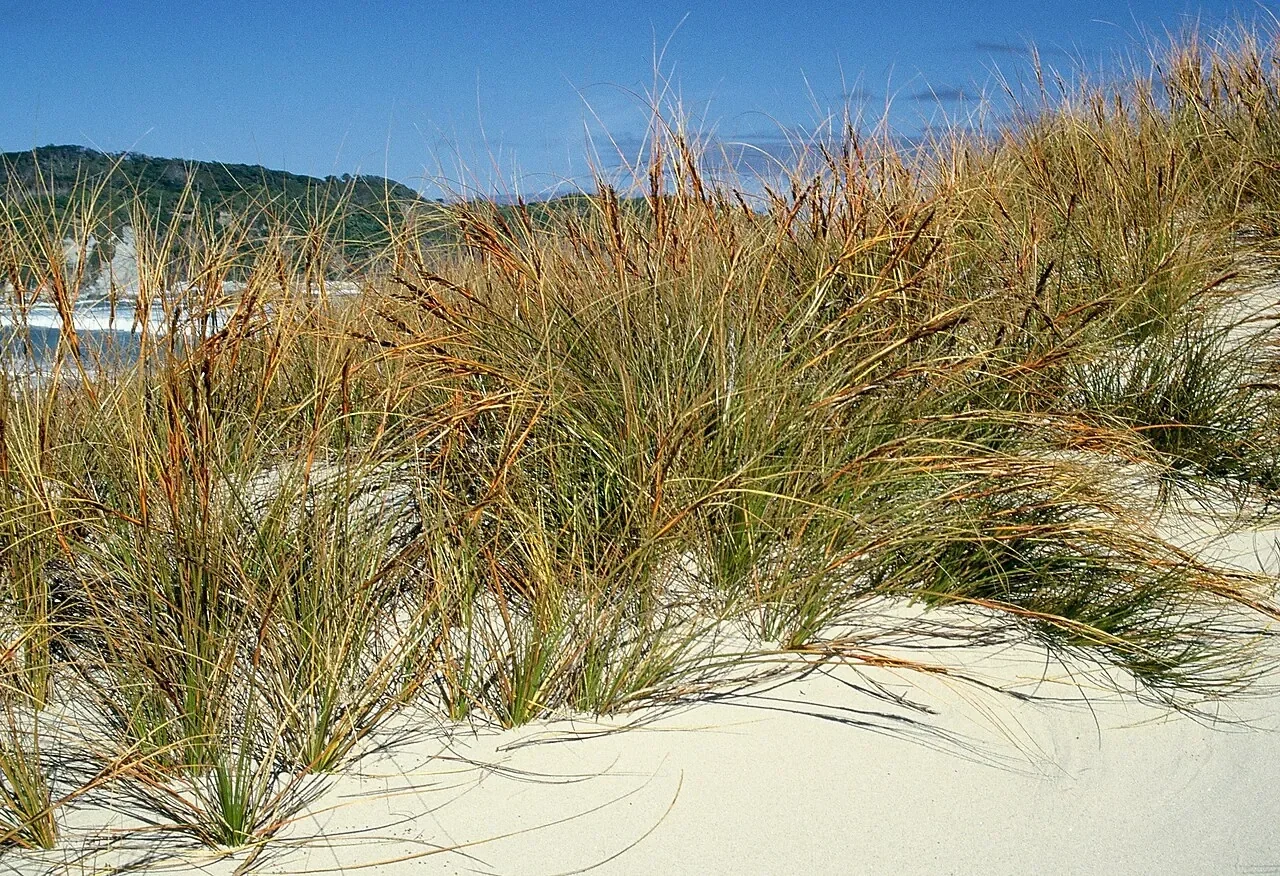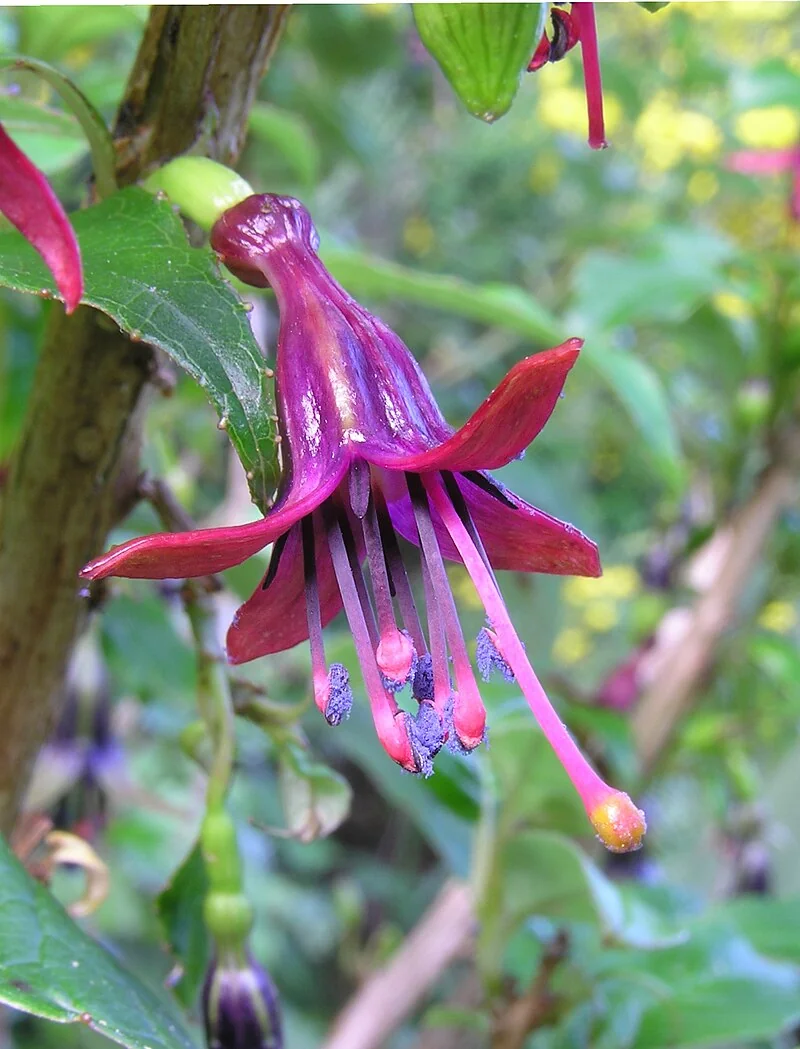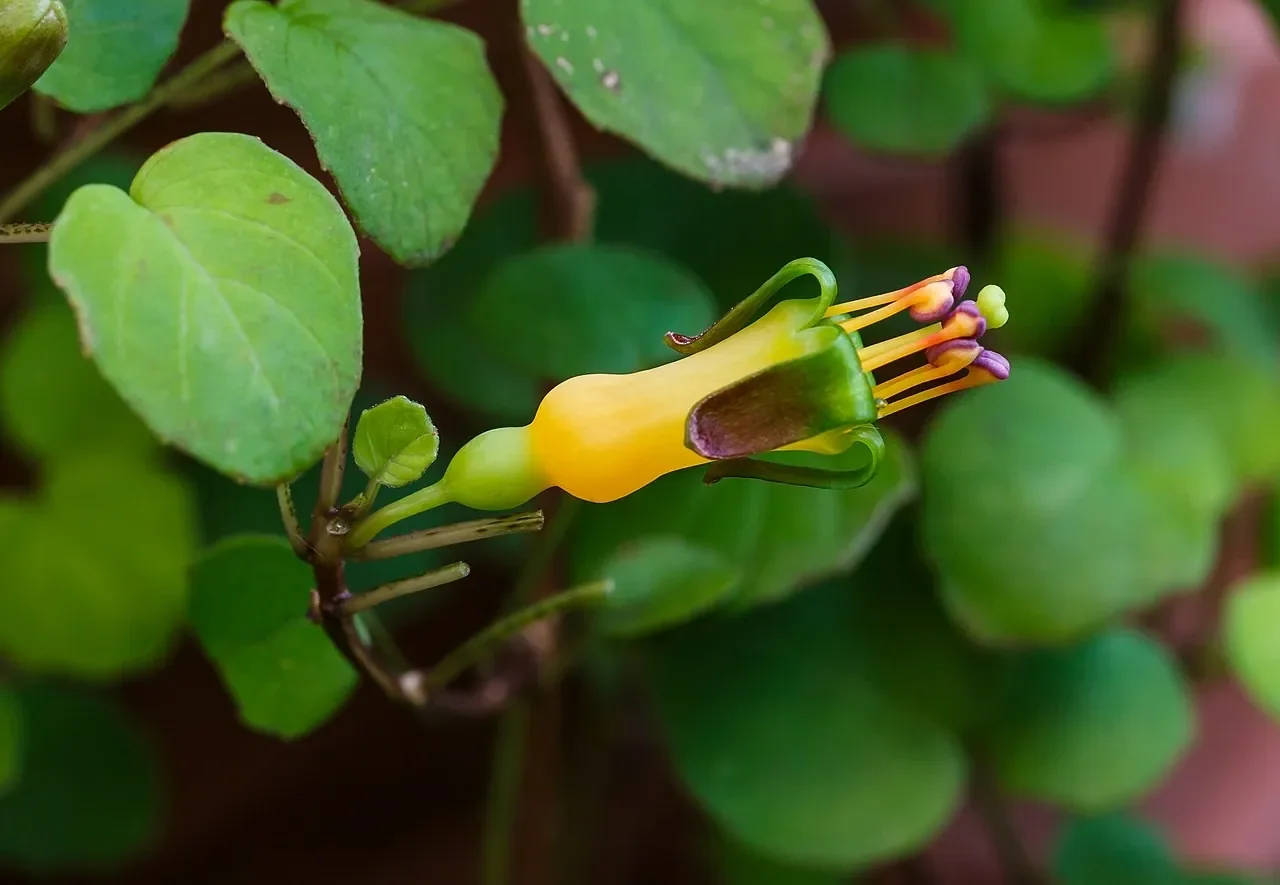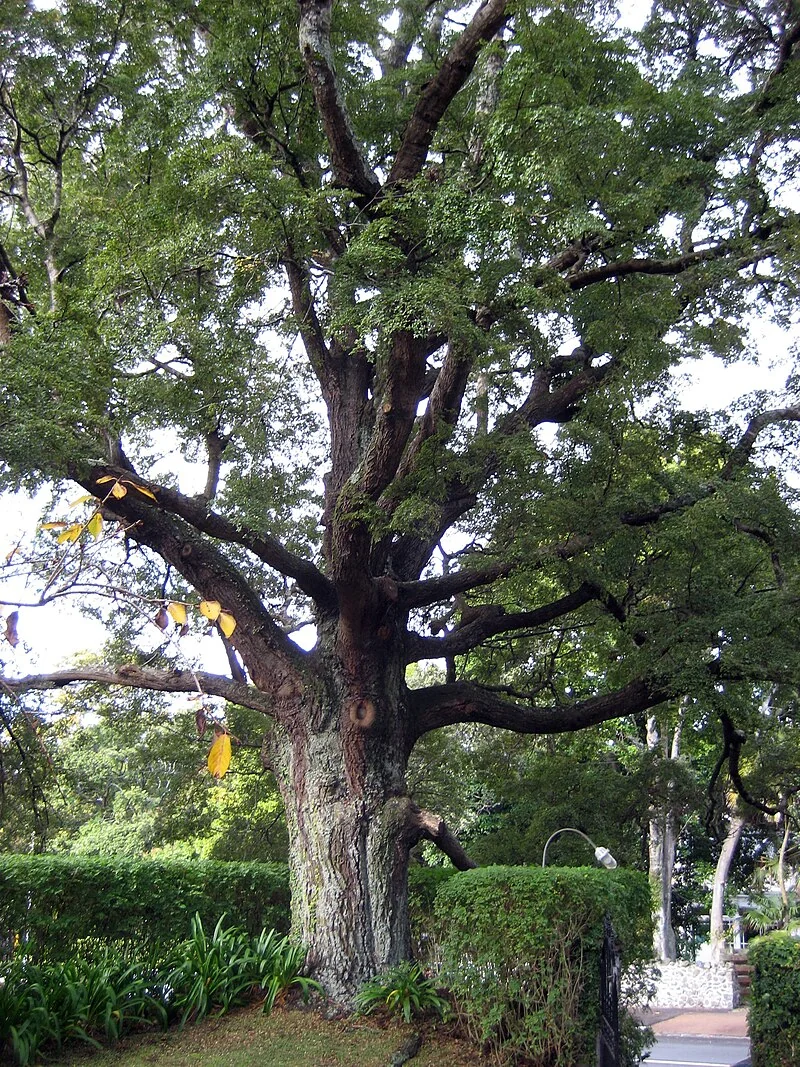
Whau
Entelea arborescens
Entelea arborescens, commonly known as whau, is a species of malvaceous tree among New Zealand's native trees endemic to New Zealand. It is the sole species in the genus Entelea. It is a shrub or small tree, typically growing up to 8 meters (26 ft) tall, with an upright-oval habit. Its trunk can reach up to 0.25 meters in diameter. The tree has large (10-25 cm long), bright green, obliquely cordate (heart-shaped) leaves with 5-7 nerves and long petioles, giving it a tropical appearance. The leaves are soft, membranous, and can be glossy. White, scented flowers with yellow filaments are borne profusely between early spring and mid-summer. They are about 2 cm (0.79 in) in diameter and have 4 or 5 sepals and petals, with a dense central tuft of yellow stamens. The distinctive dry fruit capsules are brown, subglobose to globose, and covered with rigid, black to charcoal-colored spines that are 15-25 mm long. Entelea arborescens is notable for having one of the lightest known woods, sometimes even lighter than balsa wood, with a specific gravity less than that of cork. This wood was historically used by Māori for fishing floats and marker buoys. It grows in low forest along the coast of the North Island and the northern tip of the South Island of New Zealand, including the Poor Knights and Three Kings islands. It prefers sunny, free-draining soils but can tolerate semi-shade and seasonally damp ground. It is a fast-growing but short-lived species, typically living fewer than 15 years. Its seeds are long-lived and can be stimulated to grow by fire, allowing it to establish rapidly in disturbed areas. Entelea arborescens is frost-tender, tolerating temperatures down to 3°C. It can be grown outdoors in mild climates or in a conservatory. It prefers rich, moist loam and is intolerant of drought. It is easily propagated from seed.

Plant Description
Botanical Features
Entelea arborescens, commonly known as Whau, is a species of malvaceous tree endemic to New Zealand and the sole species in the genus Entelea. It is a shrub or small tree, typically growing up to 8 meters tall, with an upright-oval habit and a trunk that can reach up to 0.25 meters in diameter. The tree has large (10-25 cm long), bright green, obliquely cordate (heart-shaped) leaves with 5 to 7 nerves and long petioles, giving it a tropical appearance. The leaves are soft, membranous, and can be glossy. White, scented flowers with yellow filaments are borne profusely between early spring and mid-summer, about 2 cm in diameter. The distinctive dry fruit capsules are brown, subglobose to globose, and covered with rigid, black to charcoal-colored spines that are 15-25 mm long. Whau is notable for having one of the lightest known woods, sometimes even lighter than balsa wood. It grows in low forest along the coast of the North Island and the northern tip of the South Island of New Zealand, preferring sunny, free-draining soils but tolerating semi-shade and seasonally damp ground. It is a fast-growing but short-lived species, typically living fewer than 15 years, with seeds that can be stimulated to grow by fire.
Quick Facts
Overview
| Scientific Name | Entelea arborescens |
|---|---|
| Height | 4-6 m |
| Spread | 3-5 m |
| Water Needs | Moderate |
| Light | Full sun to partial shade |
| Frost Tolerance | Low |
| Salt Tolerance | Moderate |
| Growth Rate | Fast |
| Lifespan | Medium |
Climate Best Suited to
Whau is a classic warm, coastal/lowland species. It thrives in frost-free, humid districts with good summer moisture and shelter from strong winds. Juveniles are frost tender.
Regional Suitability
| City | Climate Suitability |
|---|---|
| Whangārei | Ideal |
| Auckland | Ideal |
| Hamilton | Ideal |
| Tauranga | Ideal |
| Rotorua | Ideal |
| Gisborne | Ideal |
| New Plymouth | Ideal |
| Napier | Ideal |
| Whanganui | Ideal |
| Palmerston North | Ideal |
| Wellington | Ideal |
| Nelson | Ideal |
| Christchurch | Ideal |
| Dunedin | Ideal |
| Invercargill | Ideal |
Plant Habitat
Entelea arborescens, also known as whau, is a species of tree endemic to New Zealand. It is typically found in coastal to lowland forest or shrubland, often in open sites such as around recent slips, tree falls, cliff faces, boulder slopes, sand dunes, or on the margins of streams, rivers, lagoons, and lakes.
Its natural distribution includes the Three Kings Islands, the North Island (north of the Māhia Peninsula and Kawhia Harbour, and sparsely south of this), and the northern tip of the South Island, specifically around Golden Bay / Mohua and Nelson. Some inland and southern North Island occurrences are believed to be from deliberate plantings by Māori.
Plant Conservation
The conservation status of Entelea arborescens, also known as whau, is generally "Not Threatened" at a national level in New Zealand, according to assessments in 2013, 2018, and 2023.
However, there is a regional classification for Auckland in 2025 that lists Entelea arborescens as "At Risk - Regionally Declining". This regional decline is attributed to factors such as browsing pressure from cattle, goats, and horses, clearance of coastal scrub for housing, and the spread of invasive woody shrubs and trees. Despite these regional threats, the species is endemic to New Zealand and can be found across the North Island, the northern tip of the South Island, and the Three Kings Islands. It is a fast-growing, short-lived tree that naturalizes easily.
Growing Requirements
Soil Requirements
Prefers light, free-draining, fertile soils with ample organic matter. Avoid heavy, cold, waterlogged clays. The very light timber reflects rapid growth in warm conditions.
- Rich, friable loams; good drainage essential
- Mulch well to retain moisture and suppress weeds
Light Requirements
Best in full sun to light shade with shelter. Exposure to strong winds tears the large leaves and stunts growth.
- Full sun for compact habit
- Shelter from strong, salt-laden winds
Water Requirements
Maintain even moisture, especially in the first two summers. Short dry periods are tolerated once established, but regular watering promotes larger leaves and faster growth.
- Even moisture during establishment
- Deep watering in drought improves resilience
Planting Guide
Entelea arborescens, commonly known as Whau or New Zealand Mulberry, is a fast-growing native tree or large shrub from New Zealand, known for its distinctive large, heart-shaped leaves and light wood. It is ideal for restoration projects, native gardens, or as a striking feature plant in suitable climates.
1. Growing Conditions:
- Climate and Hardiness: Entelea arborescens is frost-tender, especially when young. It thrives in warm, sheltered locations and is well-suited to subtropical and temperate regions, particularly coastal areas. Mature plants may tolerate short durations of temperatures down to approximately -3°C to -5°C, but protection from frost is crucial during establishment.
- Sunlight: It prefers full sun to partial shade. Some sources suggest it prefers semi-shade, but it generally does not do well in deep shade.
- Soil: Plant in free-draining, fertile, and rich soil. While it can tolerate poorer conditions, a good deep soil is best.
- Watering: Water regularly, especially during dry spells and for the first one to two years after planting. The plant does not like to go completely dry.
2. Planting:
- Spacing: When planting multiple trees, space them about 2.5 to 3 meters apart to allow for natural growth and airflow.
- Location: Choose a sheltered spot, protected from strong winds. It is an excellent choice for coastal situations, where it can also provide shelter for other plantings.
3. Care:
- Mulching: Apply mulch around the base of the plant to help retain soil moisture and suppress weeds.
- Pruning: Minimal pruning is usually sufficient. Lightly prune to maintain shape if necessary.
- Lifespan: Whau can be relatively short-lived, with a lifespan of up to 15 years, but it often self-sows once established.
Ecological Role
Entelea arborescens, also known as whau or New Zealand Mulberry, plays several significant ecological roles within its native New Zealand ecosystems:
- Habitat and Food Source: The tree provides habitat and sustenance for various native birds and insects. Its flowers attract bees, and its fruit can serve as a food source for birds.
- Pioneer Species and Nurse Crop: Entelea arborescens is an opportunistic and fast-growing species, thriving in disturbed areas such as recent slips, tree falls, cliff faces, boulder slopes, sand dunes, and along the margins of streams, rivers, lagoons, and lakes. Its seeds are long-lived and can be stimulated to germinate by fire, allowing it to rapidly colonize these open sites. Due to its quick growth and ability to provide shade, it acts as a "nurse crop," facilitating the establishment of slower-growing, more climax tree species.
- Coastal Revegetation: Its rapid growth and tolerance to coastal conditions make it valuable for establishing shelter in coastal revegetation efforts.
Uses and Significance
Cultural and Historic Uses
Whau produces exceptionally lightweight wood traditionally used for fishing floats and net corks. The species features in coastal restoration and heritage gardens for its tropical appearance.
Showy white flowers attract pollinators; seed capsules provide seasonal interest and food for some fauna. Rapid growth makes Whau a pioneer in sheltered sites.
Landscaping Uses
Entelea arborescens, commonly known as Whau, is a versatile plant with several landscaping uses, particularly in New Zealand where it is native. Its distinctive appearance, fast growth, and large foliage make it a popular choice for various garden applications.
Key Landscaping Uses Include:
- Feature Plant/Specimen Plant: Its unique look, with large, heart-shaped, bright green leaves and attractive white flowers followed by spiky fruit, makes it suitable as a standalone feature or focal point in a garden.
- Tropical Plantings: The distinctive, tropical-like foliage of Entelea arborescens makes it ideal for inclusion in mixed plantings, especially in tropical or subtropical garden designs.
- Revegetation and Restoration Projects: Whau is a fast-growing native tree, making it excellent for restoration projects and native gardens. It's particularly useful for establishing shelter in coastal situations for other plantings.
- Coastal Gardens: It thrives in coastal conditions and is tolerant of salt, making it a good choice for gardens near the sea.
- Filler Plant: Its rapid growth to about 3 meters makes it a useful "filler" in a garden.
- Mixed Plantings: The bold foliage integrates well into mixed plantings.
- Amenity Landscaping: It has been extensively used in amenity landscaping.
While it is fast-growing and relatively low maintenance once established, it is frost-tender, especially when young, and prefers well-drained, fertile soils in full sun to partial shade. It can be relatively short-lived (up to 15 years) but easily propagates from seed and often self-sows.
Seasonal Care Calendar
Spring
Plant after last frost. Tip-prune lightly to shape.
Summer
Water deeply in dry spells; stake young trees if windy.
Autumn
Collect seed; reduce irrigation as temperatures cool.
Winter
Provide frost protection for juveniles in marginal climates.
Pruning and Maintenance
Techniques and Timing
Minimal pruning required for this fast-growing coastal native that can reach 6 metres in ideal conditions. Remove damaged or crossing branches and protect the large, soft leaves from strong winds which can tear and damage them extensively. Avoid heavy heading cuts which spoil the natural tropical form and can lead to weak regrowth in this lightweight-wooded species. Light tip-pruning in spring helps maintain compact growth and encourages bushier development, though whau naturally develops an attractive spreading canopy with age. Given its relatively short 15-20 year lifespan, focus on maintaining health and structural integrity rather than extensive pruning. Dead-heading spent flowers can redirect energy into foliage production, while removing lower branches improves air circulation around the distinctive heart-shaped leaves that characterize this unique New Zealand native.
How to Grow Whau
Whau is a unique and fast-growing native shrub or small tree, highly valued for its exceptionally lightweight wood, large heart-shaped leaves, and tropical appearance. It is a pioneer species, rapidly colonizing disturbed sites in coastal and lowland forests. While it is a short-lived tree, its rapid growth and ability to establish quickly make it an excellent choice for early successional forest restoration and for adding a dramatic, exotic touch to sheltered gardens. Understanding its propagation methods is key to successfully growing this distinctive species.
From Seed
Propagating Whau from seed is the most reliable and straightforward method. Collect the distinctive spiky seed capsules when they are mature and brown. Extract the seeds and sow them promptly in a well-draining seed-raising mix, lightly covering them. Whau seeds are known to have a hard seed coat, and germination can be improved by scarification (lightly sanding or nicking the seed coat) or by soaking the seeds in warm water for 24 hours before sowing. Maintain consistent moisture and provide warm, bright conditions for germination. Germination typically occurs readily in warm conditions, often within a few weeks. Once seedlings have developed a few true leaves, they can be potted into individual containers and grown in a sheltered, frost-free location before planting out.
From Cuttings
Whau can also be propagated from semi-hardwood cuttings, typically taken in late summer or early autumn from healthy, current season's growth. Cuttings should be about 6-8 inches long. Remove the lower leaves and dip the cut end in a rooting hormone. Plant the cuttings into a well-draining, sterile cutting mix, such as a blend of perlite and sand. Maintain high humidity around the cuttings, perhaps by placing them under a plastic dome or in a propagator, and provide bottom heat to encourage root development. Keep the medium consistently moist but not waterlogged. Rooting can be slow and success rates can vary, making this method more suitable for experienced propagators.
Pests and Diseases
Entelea arborescens, also known as Whau, is primarily affected by a few specific pests.
Pests:
- The introduced scale insects, olive scale (Saissetia oleae Olivier) and latania scale (Hemiberlesia lataniae (Signoret) Cockerell), have been recorded on Entelea in New Zealand.
Diseases:
Sources indicate that Entelea arborescens generally appears to have few diseases.
Cultural Significance
Entelea arborescens, commonly known as whau, holds significant cultural importance, particularly for the Māori people of New Zealand. Its cultural value stems primarily from the unique properties of its wood and other plant parts.
Key Aspects of Cultural Significance Include:
- Lightweight Wood for Fishing and Rafts: The whau produces one of the lightest woods in the world, even lighter than cork. This made it an invaluable resource for Māori, who used it extensively for fishing net floats (p� ito), marker buoys (kÄārewa), and to construct small rafts (m� kihi) for activities like crayfish hunting.
- Cultivation and Distribution: The plant was so highly valued that Māori actively cultivated it in some areas. Evidence suggests that Māori horticulturalists may have transported and planted whau in new locations before European settlement, contributing to its distribution beyond its natural boundaries. For instance, Auckland's iconic Mt. Eden is known in Māori as Maungawhau, meaning "The Mountain of the Whau Tree," indicating its historical abundance in the area.
- Traditional Games and Tools: Small carved pieces of whau wood were used in traditional catching games. The wood was also used for darts (teka) and poi. Long fibers from the trunk were utilized for fishing lines.
- Medicinal Uses: The sap of the whau was used in the North Island to preserve bodies, and its leaves were employed to treat piles. The jelly found beneath the bark was also used to alleviate difficult childbirth. Heated leaves were made into a poultice for treating wounds and sores.
- Writing Material: The large, soft leaves of the whau were sometimes used as a substitute for paper for writing notes and love letters, with a sharp object serving as a stylus.
- Etymology: The common name "whau" is a Māori word believed to be derived from the common Polynesian word for hibiscus, "fau," due to a superficial resemblance.
Bonus Tip
The Whau (Entelea arborescens) is full of surprises! Its wood is incredibly lightweight, even less dense than cork, making it one of the lightest woods in the world. This unique property made it invaluable to Māori for crafting fishing floats and rafts. Another fascinating fact is that, unlike most trees, Whau doesn't have distinct annual growth rings. Instead, it forms several bands of unlignified pith-like parenchyma per year. Plus, its seeds are long-lived and can remain dormant in the soil for extended periods, with fire actually stimulating them to germinate - a clever adaptation for a pioneer species in disturbed coastal areas!
